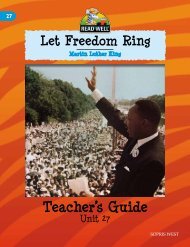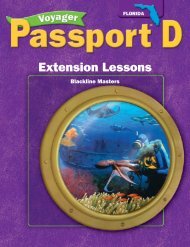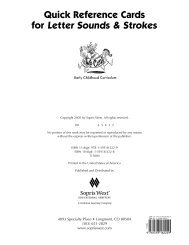Unit 19 - Voyager Learning
Unit 19 - Voyager Learning
Unit 19 - Voyager Learning
You also want an ePaper? Increase the reach of your titles
YUMPU automatically turns print PDFs into web optimized ePapers that Google loves.
STORY READING 4 • Flat Stanley, pages 34–39WITH THE TEACHERSTORY READING INSTRUCTIONSStudents read pages 34–39 with the teacher and pages 39–45 on theirown. Page 39 is split between reading sections.COMPREHENSION PROCESSESRemember, Understand, ApplyPROCEDURES1. Reviewing Chapter 3Summarizing; Inferring; Using Vocabulary—jealous, brag• Discuss Chapter 3. Say something like:In Chapter 3, we found out that Arthur was very jealous of Stanley. Howcould we tell?(Arthur tried to get flat by putting books on his chest. He said “Phooey”when Mr. Lambchop bragged about Stanley.)What did Stanley do to help Arthur feel better?(Stanley let Arthur fly him like a kite.)PREP NOTEStudents will stop andstart reading in the middleof pages 39, 49, and 60.Mark those places instudents’ books with asticky strip.• Discuss the questions from Chapter 3, Setting a Purpose. Say something like:Yesterday, you read pages 28–33 on your own. Let’s see what you found out.Why did Arthur want to fly a kite? (He thought people would pay attention to him.)Why did Stanley make a good kite?(He knew how to go up and down and swoop from side to side . . . )What kind of trouble did Stanley get into? (He got stuck in a tree.)Why was Stanley mad at Arthur? (Arthur forgot about Stanley and left him in the tree.)2. Introducing Chapter 4Defining, PredictingDiscuss Chapter 3. Say something like:This chapter is called “The Museum Thieves.” What are thieves? (Thieves are people who steal.)What do you think is going to happen in this chapter?(Someone will steal something from the museum . . . )3. First Reading• Ask questions and discuss the story as indicated by the blue text in this guide.• Mix group and individual turns, independent of your voice.Have students work toward a group accuracy goal of 0–5 errors.Quietly keep track of errors made by all students in the group.• After reading the story, practice any difficult words.Reread the story if students have not reached the accuracy goal.4. Second Reading, Timed Readings: Repeated Reading• As time allows, have students do Timed Readings while others follow along.• Time individuals for 30 seconds and encourage each child to work for apersonal best.• Determine words correct per minute. Record student scores.62





